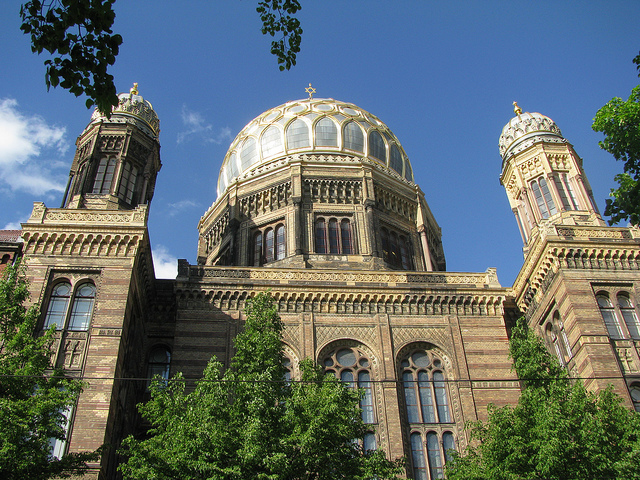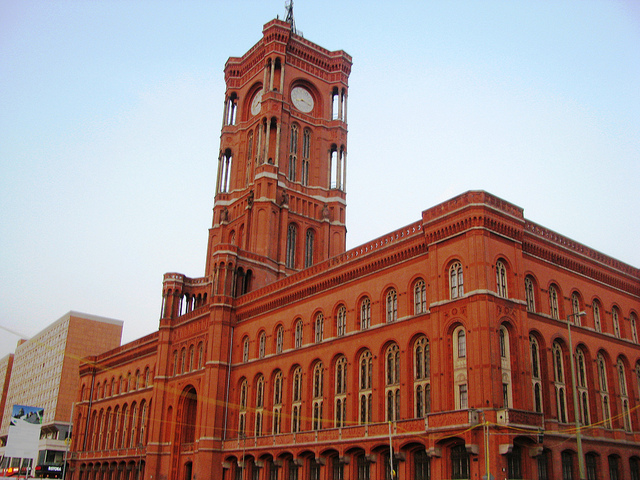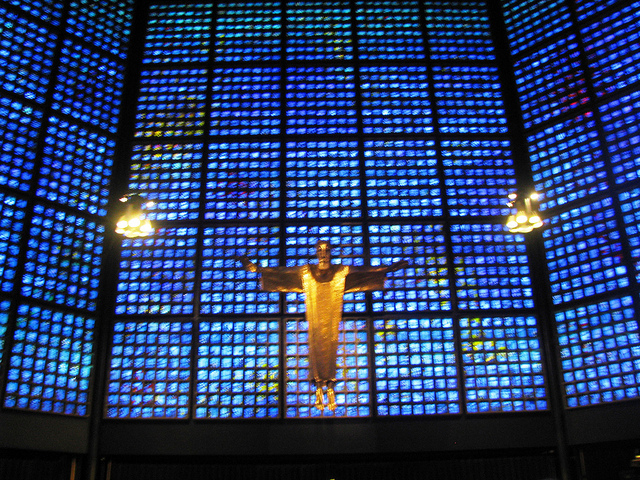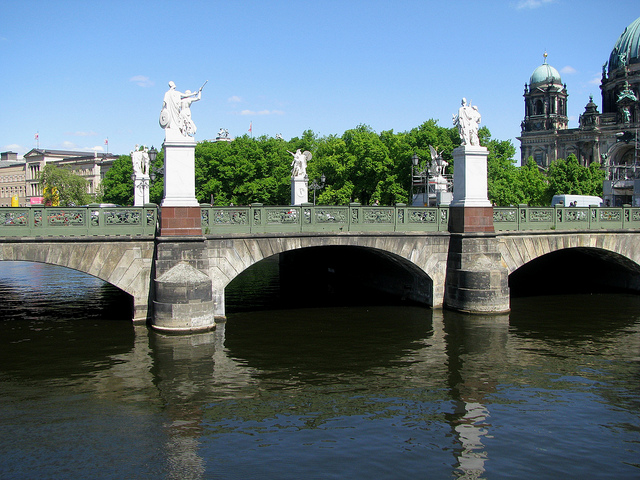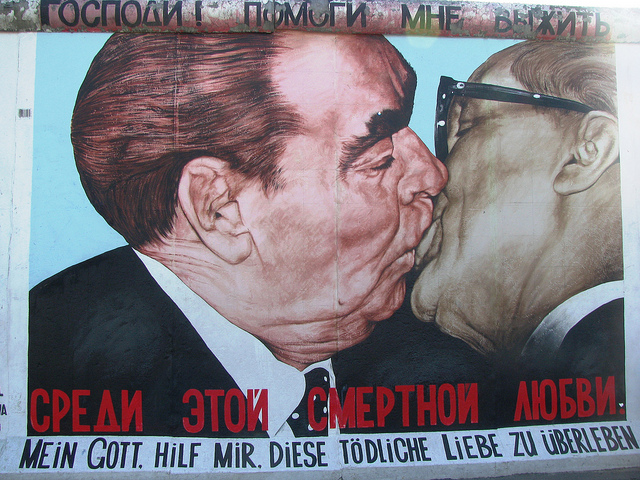More so than many other cities, Berlin is marked by its history, particularly its turbulent 20th century history. Berlin was at the heart of so many critical events of the last century – from the First World War, to the Second to the Cold War, finally to the Fall of the Berlin Wall in 1989 and the collapse of Communism. After my exciting bicycle tour on May 1, 2011 through East Berlin, I set off to learn more about Berlin’s historical places.
I started with the New Synagogue on Oranienburger Strasse, a fantastic building from the 1860s that was the main synagogue of Berlin’s large Jewish community. It was constructed in a magnificent Eastern Moorish style and boasts a rich terra cotta facade with glazed brick accents. The main dome with its flanking two smaller turrets and its gilded ribs is the main attraction. The building itself could hold about 3000 people and was the largest synagogue in Germany at the time.
During the infamous “Kristallnacht” (Night of the Broken Glass) of November 9, 1938, the New Synagogue was set afire and desecrated. A local police officer arrived on the scene early the next morning, dispersed the Nazi mob and called the fire trucks which allowed the building to be saved. However, the synagogue was closed by the Nazis in April of 1940 and was struck by Allied bombing and completely burned out during the Battle of Berlin from November of 1943 to March of 1944.

In 1958 damaged parts of the building were removed and only the street facade remained. Finally, after the Fall of the Berlin Wall, a decision was made to reconstruct the building and the restoration work was completed in 1993. The dome, the facade and some rooms were reconstructed. Although the building is no longer used as a synagogue, it does contain a small prayer room and there are several Jewish restaurants, cafés and galleries in the area.
Virtually across the street is another well-known Berlin destination: Kunsthaus Tacheles (Art House Tacheles) is an art centre that contains various ateliers, workshops, a cinema and a nightclub. Colourful graffiti murals adorn the outer walls and the interior boasts various sculptures. Although the building only sustained moderate damage during WWII, part of it was demolished in 1980. The second-level cellar was flooded during the Battle of Berlin and remains under water today.

To understand the city’s history even better I was planning to see one of Berlin’s most visited sites: the Topography of Terror, a documentation centre located on the actual site of the former headquarters of the Nazi SS and the Gestapo. I took the subway to Potsdamer Platz, one of the city’s most important squares and transportation hub. During the Cold War, the Berlin Wall used to cut right across this Square and turned it into a desolate wasteland. After German reunification, the square has undergone continuous redevelopment and has again become one of the city’s most important public spaces.
I started walking down Stresemannstrasse, not realizing that I had taken a wrong turn. All of a sudden I reached a Romanesque-inspired sandstone portal and upon closer examination, I realized that this was only a fragment of a former building. I realized that whatever had stood here before, must have been an absolutely monumental building. When I walked around I saw a plaque, indicating that this used to be the Anhalter Bahnhof, which was the largest train station in Germany when it opened in 1880 (after an earlier smaller railway station had been demolished). In 1939 a North-South S-Bahn (city railway) connection was opened here, turning the station into a major transportation hub.
The dark history of the Anhalter Bahnhof started to unfold between 1941 and 1945 when about 55,000 Berlin Jews were deported from here to the Nazi concentration camp in Theresienstadt, from where many of the victims were sent to death camps. The last Jewish deportation took place on March 27, 1945 at the very end of the war. The station had already sustained bomb damage during November of 1943 and the roof was almost completely destroyed in February of 1945. Finally after Hitler’s death in late April and early May of 1945, the Nazis blew up some tunnels close to the Landwehr Canal which ended up flooding many underground railway stations and tunnels which had been used as air raid shelters, causing hundreds of people to drown.

During the 1950s the underground portion of the Anhalter Bahnhof was restored and became an S-Bahn station. The damaged above-ground remains of the building were demolished and only the front portico of the once grand railway terminal remains. I had simply stumbled over this admonishing reminder of the past, and once I started understanding the former significance of this building I literally got chills up my spine.
I finally had my bearings back and was able to find the Topography of Terror – a site no less bone-chilling than the Anhalter Bahnhof. This outdoor museum was built on the former site of the Gestapo and SS headquarters that were almost completely destroyed in early 1945 by Allied bombing. I went inside the documentation center and absorbed the pictorial history of the organizations that terrorized populations in all Nazi-controlled areas from 1933 to 1945. There are several permanent exhibitions housed here: Topography of Terror, illustrating the history of the Gestapo, SS and Reich Security Main Office ; Berlin 1933 to 1945 – Between Propaganda and Terror; and an outside site tour that shows exposed remnants of the Nazi buildings that once stood here, all explained with large informational exhibits. A remaining part of the Berlin Wall is also part of this outdoor exhibit. It was hard to fathom that I was standing right on the location of where some of the worst atrocities in the history of mankind were conceived and strategized.

Across the street is the German Federal Ministry of Finance, actually housed in a monumental lime-stone clad building that used to be the Nazi Ministry of Aviation and was built in 1935 and 1936. In the famous Fascist tradition, the scale of the building was gigantic and, at the time of its construction, it was the largest office building in Europe, designed to impress and intimidate.
I crossed across Wilhelmstrasse and continued on Zimmerstrasse where I finally came across a more light-hearted view: the “Trabi-Safari”, which bills itself as “Germany’s funniest city tour”. The “Trabant”, or nicknamed “Trabi”, was a small vehicle that was produced in East Germany between 1957 and 1990, a product of Communist central planning. It was known for its poor design, inefficient two stroke engine, and noxious fumes. East German families often had to wait years to get their own Trabi. The Trabi Safari has turned a much ridiculed Communist-era vehicle into a sightseeing tool and visitors to Berlin can go on guided group tours in their own Trabi.
Just a few steps away is the famous Checkpoint Charlie, the most famous border crossing between East Berlin and West Berlin. On the east side of the checkpoint there used to be the Berlin Wall, a watchtower and zig-zag barriers. Cars leaving East Berlin were x-rayed to make sure that no East Germans could be smuggled into West Berlin. A replica of the original guardhouse together with oversize images of a Russian and an American soldier can still be seen today. Plenty of souvenir stands peddle mementos to the Cold War to tourists hungry for entertainment. Close by is the Checkpoint Charlie Museum which commemorates many of the daring escape attempts from the former East Germany. For anyone interested in 20th century history, Berlin is a phenomenal city to visit…

